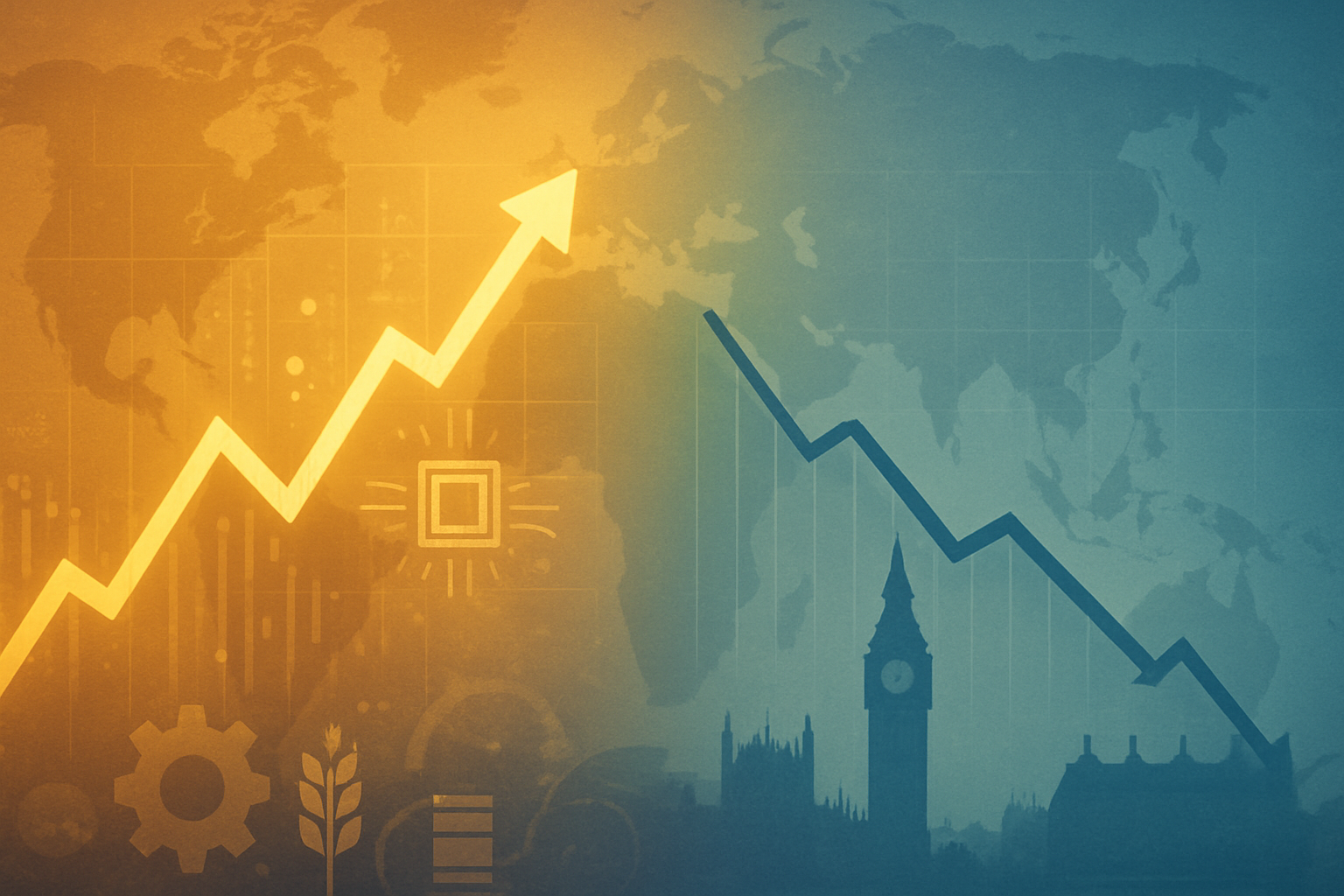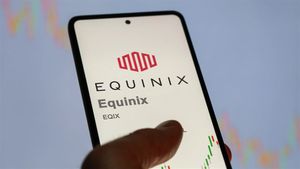
As October 2025 draws to a close, global financial markets are presenting a study in contrasts, with a significant divergence emerging between the performance of major U.S. indices and their European counterparts. Wall Street is currently experiencing a robust uplift, largely propelled by stellar earnings reports from several influential technology behemoths. This surge is fostering a cautious optimism among investors, eager to capitalize on innovation and strong corporate performance.
Conversely, the UK's FTSE 100 index has experienced a modest but notable slip, bringing an end to a remarkable winning streak. This retreat, occurring amidst a crucial earnings season, highlights a broader cautious sentiment pervading European markets. The interplay of these distinct movements, influenced by corporate profitability, economic outlooks, and central bank expectations, is setting a complex stage for global commodity demand and investor strategies in the coming months.
Earnings Power and Market Shifts
The current market landscape is heavily defined by the ongoing third-quarter 2025 earnings season, which has delivered a mixed yet impactful narrative. On Wall Street, the tech sector has once again demonstrated its capacity to drive market momentum. Amazon (NASDAQ: AMZN), for instance, saw its shares surge by an impressive 11-13% following an earnings report that significantly surpassed analyst expectations. This performance was largely attributed to a robust 20% increase in sales from its cloud computing division, Amazon Web Services (AWS), a testament to the escalating demand for artificial intelligence (AI) computing power. Similarly, Apple (NASDAQ: AAPL) contributed to the positive sentiment with better-than-expected results, showcasing record-breaking iPhone sales and strong services revenue.
However, the tech sector's narrative isn't uniformly bullish. Meta Platforms (NASDAQ: META) experienced a notable drop of over 11% as investors grappled with concerns over its substantial AI infrastructure spending. Microsoft (NASDAQ: MSFT) also saw its shares decline by about 3% despite a positive earnings report, as similar reservations regarding the capital intensity of AI development weighed on investor minds. This indicates a growing scrutiny of whether these massive AI investments will translate into proportionate revenue streams and sustainable profitability.
Across the Atlantic, the UK's FTSE 100 index presented a different picture. On October 31, 2025, the index experienced a slight slip of approximately 0.2% to 0.4% at the open, effectively ending a remarkable nine-day winning streak that had pushed it to recent record highs. This retreat was broad-based, with significant declines observed in banking, mining, and energy stocks. The cautious risk appetite across global markets, coupled with investors locking in recent profits and lingering concerns over the weak economic outlook in China, particularly affected FTSE 100 constituents such as Standard Chartered (LSE: STAN), HSBC (LSE: HSBA), and luxury brand Burberry (LSE: BRBY). Despite this daily dip, the FTSE 100 has still posted impressive year-to-date gains of 19.2%, indicating underlying resilience despite the recent pullback.
Corporate Fortunes: Winners and Losers in a Volatile Market
The current market dynamics are creating a clear delineation between companies poised for gains and those facing headwinds, particularly with implications for commodity demand. The U.S. technology giants driving Wall Street's ascent are undoubtedly in the "win" column. Companies like Amazon (NASDAQ: AMZN) and Apple (NASDAQ: AAPL), with their strong earnings, robust cloud services (AWS), and resilient consumer product demand, are benefiting from continued digital transformation and consumer spending. Their success, especially in areas requiring significant data center expansion and advanced manufacturing, indirectly fuels demand for certain high-tech components and specialized materials, though perhaps not traditional bulk commodities. The massive AI investments, despite investor scrutiny, are also driving demand for advanced semiconductors and related infrastructure, benefiting chipmakers and equipment providers.
Conversely, the sectors leading the FTSE 100's recent decline are feeling the pressure. Mining companies (LSE: GLEN, LSE: RIO), energy firms (LSE: SHEL, LSE: BP.), and certain financial institutions (LSE: LLOY, LSE: BARC) are more directly exposed to global economic sentiment, particularly from China, and commodity price fluctuations. A weaker outlook for industrial activity or consumer spending in key global markets directly translates into reduced demand for raw materials like metals, oil, and gas. For instance, concerns over China's economic health, a major consumer of commodities, immediately impact the prospects of mining giants and commodity traders. The cautious profit-taking in these sectors suggests that investors are bracing for potential slowdowns in industrial output and global trade, which are critical drivers of commodity consumption.
The divergence also highlights a potential shift in investment focus. While tech companies thrive on innovation and digital services, traditional industrial and commodity-linked companies rely on tangible economic growth and physical demand. If the earnings season continues to reflect strong consumer spending in tech but muted industrial activity globally, it could further widen this gap. Companies like Standard Chartered (LSE: STAN) and HSBC (LSE: HSBA), with significant exposure to Asian markets, are particularly vulnerable to any economic slowdowns, as their lending and trade finance activities are directly tied to cross-border commerce and industrial production.
Wider Significance: A Glimpse into Global Economic Health
The current market divergence between a tech-driven Wall Street and a slipping FTSE 100 carries broader implications for global economic health and commodity markets. This trend underscores a growing chasm between the digital economy, which continues to show resilience and growth through innovation and services, and the traditional industrial economy, which remains more susceptible to macroeconomic headwinds. This fits into a broader industry trend of technology commanding an increasingly dominant share of market capitalization and investor attention, often at the expense of more cyclical, commodity-dependent sectors.
Potential ripple effects on competitors and partners are significant. For commodity producers, a sustained period of lower industrial activity, particularly in major manufacturing hubs like China, could lead to oversupply and price depression for base metals, crude oil, and other raw materials. This would impact not only the mining and energy giants but also smaller exploration companies and logistics providers. Conversely, the robust performance of U.S. tech firms, while not directly consuming vast quantities of raw materials, does drive demand for specialized components, rare earth elements, and advanced manufacturing processes, indirectly benefiting certain niche commodity suppliers.
Regulatory and policy implications are also at play. Central banks, including the U.S. Federal Reserve and the Bank of England, are closely watching these economic indicators. Expectations are building for a potential Federal Reserve rate cut by March 2026, which could further fuel growth stocks, including tech. In contrast, the Bank of England might consider a rate cut sooner, possibly next week, driven by slowing growth and easing inflation in the UK. Such monetary policy divergences could exacerbate the performance gap between regions, influencing capital flows and the relative attractiveness of different asset classes. Historically, periods of significant divergence between major economic blocs have often preceded shifts in global trade patterns and commodity demand, with capital tending to flow towards regions offering higher growth prospects.
What Comes Next: Navigating the Shifting Sands
Looking ahead, the market's current trajectory suggests a period of continued careful navigation for investors. In the short term, the performance of tech stocks on Wall Street will likely remain highly sensitive to further earnings reports and guidance, particularly concerning the profitability and return on investment of massive AI-related expenditures. Any indication that these investments are not translating into expected revenue growth could lead to volatility in the sector. For the FTSE, the immediate future hinges on incoming economic data, especially Eurozone inflation figures and the Bank of England's monetary policy decisions. A rate cut could provide a much-needed boost to the UK economy, potentially stabilizing or even reversing the recent slip in the FTSE 100.
In the long term, the divergence could lead to a re-evaluation of investment strategies. Should the digital economy continue to outperform the industrial sector, capital might increasingly gravitate towards technology and innovation-driven companies, potentially leaving traditional commodity-linked investments relatively undervalued. This could present both challenges and opportunities. For commodity markets, the key will be global industrial activity and consumer spending forecasts. If robust tech earnings lead to increased consumer confidence and broader economic expansion, it could eventually translate into higher demand for commodities. However, if the tech boom is isolated and industrial growth remains subdued, commodity prices could face sustained pressure.
Potential strategic pivots or adaptations will be crucial for companies in both winning and losing sectors. Tech giants will need to demonstrate clear pathways to profitability from their AI investments, while industrial and commodity firms may need to focus on efficiency, diversification, and exploring new markets to mitigate risks associated with regional economic slowdowns. Market opportunities may emerge in niche commodity markets tied to advanced manufacturing or green technologies, even as traditional bulk commodities face headwinds. Conversely, challenges will include navigating potential supply chain disruptions and adapting to evolving geopolitical and economic landscapes. Scenarios range from a continued tech-led global expansion that eventually lifts all boats, including commodity demand, to a prolonged period of two-speed global growth where the digital economy thrives while traditional industries struggle, creating persistent pressure on commodity prices.
Comprehensive Wrap-Up: A Market at a Crossroads
In summary, the financial markets as of late October 2025 are at a crossroads, characterized by a striking divergence between the buoyant performance of U.S. tech stocks and the cautious retreat of the UK's FTSE 100. Key takeaways include the immense power of innovation-driven tech earnings to propel indices, alongside a growing investor scrutiny over the cost-benefit of AI investments. Simultaneously, the FTSE's slip underscores the sensitivity of traditional sectors, like banking, mining, and energy, to global economic uncertainties, particularly those emanating from China. This mixed picture highlights a global economy operating on different speeds, with digital transformation driving one segment and macroeconomic concerns weighing on another.
Moving forward, the market will assess the durability of the tech rally and the resilience of traditional industries. The implications for commodity demand are nuanced: while the direct impact of tech earnings on bulk commodities might be limited, the overall health of the global economy, as reflected in broader earnings and central bank policies, will ultimately dictate demand for raw materials. A robust global economic expansion, perhaps spurred by the positive sentiment from tech, could eventually trickle down to boost industrial activity and commodity consumption. However, a prolonged period of uneven growth could keep commodity markets under pressure.
Investors should watch for several key indicators in the coming months. These include further corporate earnings reports, especially from companies with significant global industrial exposure, to gauge the true health of manufacturing and trade. Central bank communications regarding interest rate policies in both the U.S. and Europe will be critical, as they will influence capital costs and investment flows. Additionally, economic data from major commodity-consuming nations, particularly China, will provide vital clues about future demand. The ability of companies to innovate and adapt, coupled with a clearer global economic trajectory, will define market performance and commodity dynamics in the foreseeable future.
This content is intended for informational purposes only and is not financial advice





